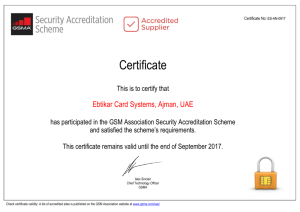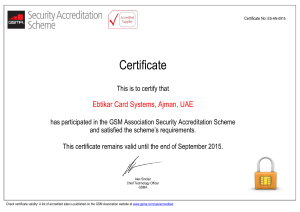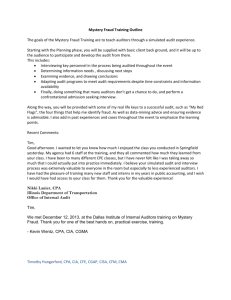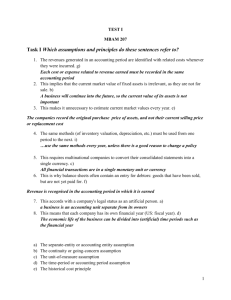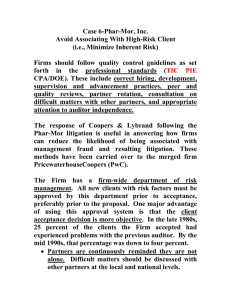- AccountingWEB
advertisement
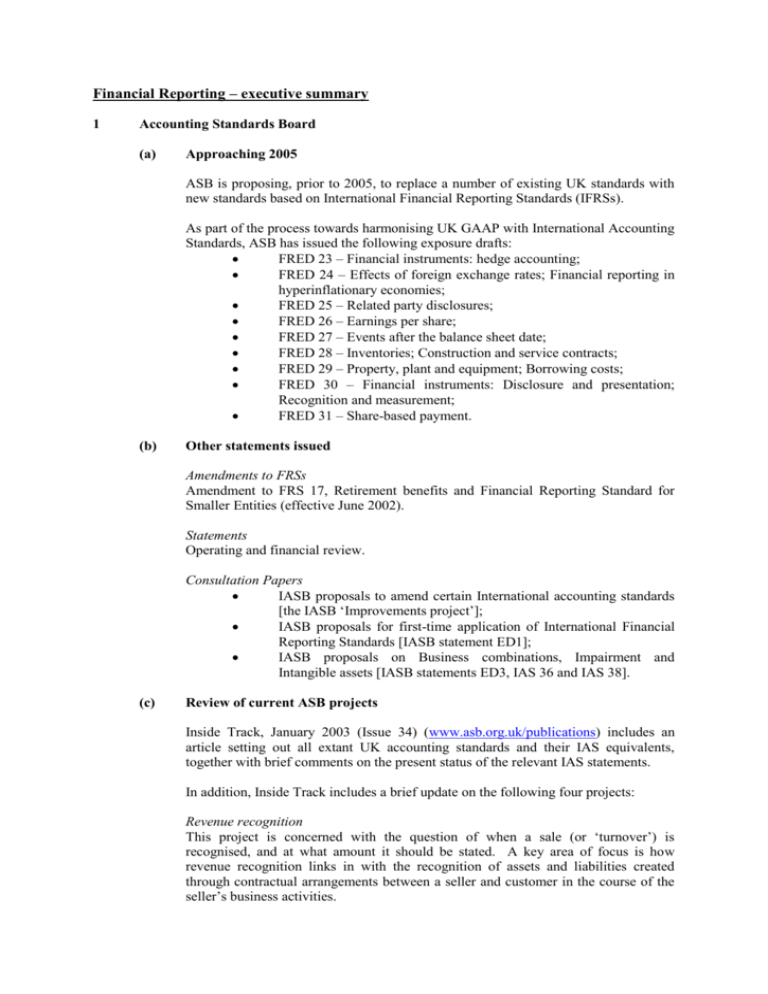
Financial Reporting – executive summary 1 Accounting Standards Board (a) Approaching 2005 ASB is proposing, prior to 2005, to replace a number of existing UK standards with new standards based on International Financial Reporting Standards (IFRSs). As part of the process towards harmonising UK GAAP with International Accounting Standards, ASB has issued the following exposure drafts: FRED 23 – Financial instruments: hedge accounting; FRED 24 – Effects of foreign exchange rates; Financial reporting in hyperinflationary economies; FRED 25 – Related party disclosures; FRED 26 – Earnings per share; FRED 27 – Events after the balance sheet date; FRED 28 – Inventories; Construction and service contracts; FRED 29 – Property, plant and equipment; Borrowing costs; FRED 30 – Financial instruments: Disclosure and presentation; Recognition and measurement; FRED 31 – Share-based payment. (b) Other statements issued Amendments to FRSs Amendment to FRS 17, Retirement benefits and Financial Reporting Standard for Smaller Entities (effective June 2002). Statements Operating and financial review. Consultation Papers IASB proposals to amend certain International accounting standards [the IASB ‘Improvements project’]; IASB proposals for first-time application of International Financial Reporting Standards [IASB statement ED1]; IASB proposals on Business combinations, Impairment and Intangible assets [IASB statements ED3, IAS 36 and IAS 38]. (c) Review of current ASB projects Inside Track, January 2003 (Issue 34) (www.asb.org.uk/publications) includes an article setting out all extant UK accounting standards and their IAS equivalents, together with brief comments on the present status of the relevant IAS statements. In addition, Inside Track includes a brief update on the following four projects: Revenue recognition This project is concerned with the question of when a sale (or ‘turnover’) is recognised, and at what amount it should be stated. A key area of focus is how revenue recognition links in with the recognition of assets and liabilities created through contractual arrangements between a seller and customer in the course of the seller’s business activities. ASB hopes that its work will provide a useful contribution to the joint project presently under way between IASB and the US’s Financial Accounting Standards Board. However, in view of on-going questions and issues concerning revenue recognition, ASB is considering whether it should issue more general guidance as an interim measure. In February 2003 ASB issued an exposure draft of an amendment to FRS 5, Reporting the Substance of Transactions: Revenue Recognition. Comments are invited by 30 May 2003. The intention is that this amendment will be mandatory for accounting periods ending on or after 22 September 2003. Performance reporting This joint project between ASB and IASB aims at developing a single statement of comprehensive income. Presently, the intention is to introduce a ‘matrix format’ which would require items to be allocated into one of four categories. The format would make a distinction between ‘business’ and ‘financing’. It would also require separate presentation of gains and losses resulting from the remeasurement of assets and liabilities (for example, fixed asset revaluations and actuarial gains and losses on defined benefit pension schemes). ASB/IASB hope to publish an exposure draft in mid-2003. Measurement Two separate standard-setting groups are developing proposals relating to measurement: Standard-setters from Australia, New Zealand, South Africa and the UK are considering a model to provide a consistent basis of revaluation internationally – this would involve an amendment to IAS 16, Property, plant and equipment; The Canadian standard-setter is looking initially at the basis that should first be used when assets are first recognised. Leases and service concessions – Rights of use ASB is continuing to develop an approach to leases that would eliminate the distinction between operating leases and finance leases. 2 UITF developments On 28 November 2002, UITF published proposed Abstract, Contracts for sales of capacity. This deals with certain issues related to the accounting by providers of network capacity (for example, in the telecommunications and electricity industries) that enter into contracts to provide rights to use capacity on their networks. The final version of this Abstract was issued as UITF Abstract 36, Contracts for sales of capacity on 27 March 2003. On 19 December 2002 UITF withdrew Abstract 10, Disclosure of share options. 3 Financial Reporting Review Panel FRRP published Press Notice 75, dealing with the 2001 accounts of Finelot plc, on 31 January 2003. 4 Company law update During January 2003, DTI published a number of papers relating to post Enron initiatives: Derek Higg’s review of the role and effectiveness of non-executive directors; Sir Robert Smith’s review on combined code guidance for audit committees; Co-ordinating Group on audit and accounting issues; Review of the regulatory regime of the accountancy profession. 5 International Accounting Standards Board developments, including Consultation Paper issued by DTI (a) Recent developments The IAS Regulation The ‘IAS Regulation’ requires all EU-listed (publicly traded) companies to prepare their consolidated accounts in accordance with IAS for financial years commencing on or after 1 January 2005. This includes AIM and OFEX companies. The Regulation applies only to the detailed accounting provisions. Domestic law will continue to apply in other areas, for example: the requirement to prepare accounts; auditing; enforcement; the directors’ report. Recently issued exposure drafts IASB has issued the following exposure drafts: Improvements to various International Accounting Standards (May 2002); Amendments to IAS 32 and 39 on Financial Instruments (June 2002); ED1, First-time application of International Accounting Standards (July 2002); ED 2, Share-based payment (November 2002); ED 3, Business combinations (December 2002); Improvements to IAS 36, Impairment of assets, and IAS 38, Intangible assets (December 2002). UK consultation In July 2002, ASB published a consultation paper dealing with IASB’s proposals for first-time application of IFRSs. On 30 August 2002, DTI published a Consultation Document on the possible extension of the European Regulation on International Accounting Standards. Under the Regulation, each Member State may either permit or require: Publicly-traded companies to prepare their individual accounts in accordance with adopted IAS; Some or all non-publicly traded companies to prepare their consolidated and/or individual accounts in accordance with adopted IAS. The Consultation Document asks a number of questions, for example: Q2 (b) If you think that the Regulation should be extended, do you consider that this should be: (a) on a voluntary basis whereby the Government permits some or all companies to comply with adopted IAS? (b) on a compulsory basis whereby the Government requires some or all companies to comply with adopted IAS? Convergence Handbook update In August 2002 ICAEW published ‘The implications of IAS for UK companies – the second update to the Convergence Handbook’ (first published in December 2000). This refers to a number of differences between current UK GAAP and current IAS, for example: Cash flow statements; Deferred tax; Development costs. The update can be accessed from ICAEW’s web site. (c) IASB/FASB activity and progress towards ‘Global GAAP’ Memorandum of understanding The US’s Financial Accounting Standards Board and the IASB issued a joint press release on 29 October 2002, referring to the issue of a ‘memorandum of understanding, marking a significant step towards formalising their commitment to the convergence of US and international accounting standards’. The two bodies have agreed to: Undertake a short-term project aimed at removing a variety of individual differences between US GAAP and IFRSs /IASs; Remove other differences between IFRSs and US GAAP that will remain as at 1 January 2005; Continue progress on the joint projects which they are currently undertaking; Encourage their respective interpretative bodies to co-ordinate their activities. Joint projects Topics for review under the joint FASB/IASB convergence project include: Construction contracts (IAS 11); Accounting in hyperinflationary economies (IAS 29); Taxes (IAS 12); Pensions (IAS 19); Government grants (IAS 20); Interim financial reporting (IAS 34); Discontinued operations (IAS 35); Provisions (IAS 37). Examples of areas of difference An article in Accountancy, November 2002, page 97, by Paul Pacter of Deloitte Touche Tohmatsu contains a highly useful topic by topic comparison between IAS and US GAAP. (d) IASB project update and timetable Rough projections for arrival of key documents are as follows: Topic 2002 2003 First-time application of International Financial Reporting Standards Improvements to existing IASs Amendments to IAS 39/32 Activities of financial institutions: disclosures and presentation Business combinations, Phase 1 ED 1 published IFRS ED published ED published ED due IFRS IFRS IFRS ED 3 published December 2002 IFRS Insurance contracts Accounting for share-based payment Reporting performance ED 2 published November 2002 ED on Phase 1 – Q1 IFRS ED due first half 2003 Audit and Assurance – executive summary 1 Auditing Practices Board (APB) In November 2002, APB issued a 63-page publication entitled ‘Audit Quality’. APB issued an alert in February 2003 concerning issues associated with the inclusion of pro forma information in preliminary announcements. 2 International Auditing and Assurance Standards Board (IAASB) IAASB issued the following exposure drafts in October 2002: ISA 400, Understanding the entity and its environment and assessing the risk of material misstatement; ISA 401, The auditors ‘ procedures in response to assessed risks; ISA 500, Audit evidence; Reporting on compliance with International Financial Reporting Standards; Amendment to ISA 200, Objective and general principles governing an audit of financial statements; Audit risk, proposed international standards on auditing. In November 2002, the following were issued: Proposed terms of reference; Preface to the international standards on quality control, auditing, assurance and related services; Operations policy No 1 – Bold type lettering. 3 Audit exemption The DTI White Paper on Modernising Company Law, published July 2002, stated: The Government did not propose to introduce a statutory Independent Professional Review (IPR) as a replacement for statutory audit; There would continue to be a threshold below which no audit is required; The Government intended to consult further and assess the impact of raising the turnover threshold in July 2000 from £350,000 to £1m before making a final decision on whether to increase the level further. Subsequently, in the pre-budget report, the Chancellor announced that the Government would consult during 2003 on audit exemption deregulation for medium-sized firms. More recently, the DTI has launched a research programme to assess the impact of extending the turnover threshold from £350,000 to £1m. The results of this research will be used as part of the consultation referred to above. Currently, under EU law, the audit exemption turnover threshold could be raised as high as £4.8m. 4 ICAEW pronouncements ICAEW’s Audit and Assurance Faculty has issued the following guidance statements: Management representation letters – explanatory note (November 2002); The audit report and auditors’ duty of care to third parties (January 2003) issued following the Bannerman case decision in 2002. 5 Department of Trade and Industry In January 2003, DTI issued the following reports as part of its post Enron initiatives: The Higgs review of the ‘Role and effectiveness of non-executive directors’; The Smith review on ‘Combined code guidance for audit committees’; The final report of the Co-ordinating Group on Audit and Accounting Issues; The report of the ‘Review of the Regulatory Regime of the Accountancy Profession’. These can be accessed from the Company Law part of the DTI web site (www.dti.gov.uk/cld/). Appendix 1 – Key dates The Statements below are mandatory for financial years ending on or after the dates indicated (except Abstract 31 which applies to periods commencing on or after): 22 January 2002 FRS 19 Deferred tax 23 March 2002 Abstract 33 Obligations in capital instruments FRS 17 Retirement benefits – memorandum disclosures for defined benefit schemes (second year transitional arrangements) Pre-contract costs Death-in service and incapacity benefits 22 June 2002 Abstract 34 Abstract 35 23 December 2001 (periods commencing on or after) Abstract 31 Exchanges of businesses or other non-monetary assets Appendix 2 – UK GAAP status report as at 31 January 2003 Note – ASB’s Inside Track, Issue 34, January 2003, includes a list of the International Accounting Standard equivalent of each of the UK GAAP statements referred to below, with a brief comment on the status of each IAS statement as at the start of 2003. Statements of Standard Accounting Practice Number Title Status/Developments SSAP 4 The accounting treatment of government grants Accounting for value added tax Stocks and long term contracts Accounting for research and development Accounting for deferred taxation FRED 28 – Inventories; Construction and service contracts SSAP 5 SSAP 9 SSAP 13 SSAP 15 SSAP 17 SSAP 19 SSAP 20 SSAP 21 SSAP 24 SSAP 25 Superseded by FRS 19 for accounts periods ending on or after 23 January 2002 Accounting for post FRED 27 – Events after the balance balance sheet events sheet date Accounting for investment properties Foreign currency FRED 24 – The effects of changes in translation foreign exchange rates; Financial reporting in hyperinflationary economies Accounting for leases and Under review – Discussion Paper hire purchase contracts – amended in relation to treatment of tax-free grants Accounting for pension Superseded by FRS 17 – must be costs adopted in full for accounts periods beginning on or after 1 January 2005; detailed memorandum disclosures required for accounts periods ending on or after 22 June 2001 Segmental reporting Financial Reporting Standards Number Title FRS 1 FRS 2 Cash flow statements Accounting for subsidiary undertakings Reporting financial performance Under review: FRED 22 Revision of FRS 3 Capital instruments Abstract 33 – Obligations in capital instruments FRS 3 FRS 4 FRS 5 FRS 6 FRS 7 FRS 8 FRS 9 FRS 10 FRS 11 FRS 12 FRS 13 FRS 14 FRS 15 FRS 16 FRS 17 Status/Developments FRED 30 – Financial Instruments: Disclosure and presentation; Recognition and measurement Reporting the substance of Exposure draft – Revenue transactions recognition Acquisitions and mergers Consultation Paper on Business combinations Fair values in acquisition Consultation Paper on Business accounting combinations Related party disclosures FRED 25 – Related party disclosures Associates and joint ventures Goodwill and intangible assets Consultation Paper on Intangibles Impairment of fixed assets and Consultation Paper on goodwill Impairment of assets Provisions and contingencies Derivatives and other financial FRED 30 – Financial instruments Instruments: Disclosure and presentation; Recognition and measurement Earnings per share FRED 26 – Earnings per share Tangible fixed assets FRED 29 – Property, plant and equipment; Borrowing costs Current tax Retirement benefits Abstract 35 – Death-in service and incapacity benefits Mandatory date for full implementation postponed to 2005 FRS 18 FRS 19 FRSSE Other Accounting policies Deferred tax Financial reporting Standard for Smaller Entities (effective June 2002) Statement of principles for A cornerstone of UK GAAP financial reporting although it does not have the mandatory status of an FRS Financial Reporting Exposure Drafts Number Title FRED 22 Revision of FRS 3, Reporting Unlikely to progress to FRS Financial Performance Financial instruments: Hedge accounting The effects of changes in foreign exchange rates FRED 23 FRED 24 FRED 28 Financial reporting in hyperinflationary economies Related party disclosures Earnings per share Events after the balance sheet date Inventories FRED 29 Construction and service contracts Property plant and equipment FRED 25 FRED 26 FRED 27 FRED 30 FRED 31 Borrowing costs Financial Instruments: Disclosure and presentation; Recognition and measurement Share-based payment Status/Developments Abstracts issued by UITF Number Title Abstract 4 Presentation of long term debtors in current assets Transfers from current assets to fixed assets Accounting for post-retirement benefits other than pensions Accounting for operations in hyperinflationary economies Accounting for issuer call options Accounting for ESOP trusts Disclosure of substantial acquisitions Employee share schemes Pension costs following the 1997 tax changes in respect of dividend income Tax on gains and losses on foreign currency borrowings that hedge an investment in a foreign enterprise Accounting issues arising from the proposed introduction of the Euro The acquisition of a Lloyd’s business Application of transitional rules in FRS 15 Accounting for start-up costs National Insurance contributions on share option gains Barter transactions for advertising Revisions to estimated useful economic life of goodwill and intangible assets Operating lease incentives Web site development costs Date of award to employees of shares or right to shares Exchanges of businesses or other non-monetary assets for an interest in a subsidiary, joint venture or associate Employee benefit trusts and other intermediate payment arrangements Obligations in capital instruments Pre-contract costs Death-in service and incapacity benefits Abstract 5 Abstract 6 Abstract 9 Abstract 11 Abstract 13 Abstract 15 (revised) Abstract 17 (revised) Abstract 18 Abstract 19 Abstract 21 Abstract 22 Abstract 23 Abstract 24 Abstract 25 Abstract 26 Abstract 27 Abstract 28 Abstract 29 Abstract 30 Abstract 31 Abstract 32 Abstract 33 Abstract 34 Abstract 35 Status/Developments Superseded by FRS 17 FRED 24 FRED 30 FRED 31 Superseded by FRS 17 FRED 24 – The effects of changes in foreign exchange rates Read in conjunction with Abstract 17 and Abstract 25 FRED 30 Appendix 3 – Status of Audit and Assurance documents Statements of Auditing Standards (SASs) Number Title Status/Developments SAS 100 Objectives and general principles governing an audit of financial statements SAS 110 Fraud and error SAS 120 Consideration of law and regulations SAS 130 The going concern basis in financial statements SAS 140 Engagement letters SAS 150 Subsequent events SAS 160 Other information in documents containing audited financial statements (Revised) SAS 200 Planning SAS 210 Knowledge of the business SAS 220 Materiality and the audit SAS 230 Working papers SAS 240 Quality control for audit work (Revised) SAS 300 Accounting and internal control systems and audit risk assessments SAS 400 Audit evidence SAS 410 Analytical procedures SAS 420 Audit of accounting estimates SAS 430 Audit sampling SAS 440 Management representations Supplemented by guidance in ICAEW Technical Release Aud 4/02 SAS 450 Opening balances and comparatives SAS 460 Related parties Proposed priority for APB work programme - review in context of ‘business empires’, recent experience and proposed changes to FRS 8 SAS 470 Overall review of financial statements SAS 480 Service organisations SAS 500 Considering the work of internal audit SAS 510 The relationship between principal and other auditors SAS 520 Using the work of an expert SAS 600 Auditors’ reports on financial statements ICAEW Technical Release Audit 1/03 (The audit report and auditors’ duty of care to third parties) SAS 601 Imposed limitation of audit scope SAS 610 Communication of audit matters to those charged Proposed priority for APB work with corporate governance (Revised) programme SAS 620 The auditors’ right and duty to report to regulators in the financial sector Practice Notes (PN) The auditors’ right and duty to report to the Friendly Societies Commission PN 8 Reports by auditors under company legislation in the United Kingdom PN 9 Reports by auditors under company legislation in the Republic of Ireland PN 10 Audit of financial statements of public sector entities in the United Kingdom (Revised) PN 10 The audit of central government financial (I) statements in Ireland PN 11 The audit of charities in the United Kingdom (Revised) PN 12 Money laundering PN 13 The audit of small businesses PN 14 The audit of registered social landlords in the United Kingdom PN 15 The audit of occupational pension schemes in the United Kingdom PN 16 Bank reports for audit purposes Explanatory note (ICAEW Technical Release Audit 3/02) PN 18 The audit of building societies in the United Kingdom PN 19 Banks in the United Kingdom PN 19 Banks in the Republic of Ireland (I) PN 20 The audit of insurers in the United Kingdom PN 20 The audit of insurers in the Republic of Ireland (I) PN 21 The audit of investment businesses in the United Kingdom PN 22 The auditors’ consideration of FRS 17 ‘Retirement Benefits’ – Defined Benefit Schemes PN 23 Auditing Financial Instruments PN 24 The audit of friendly societies in the United Kingdom PN 7 Bulletins 1997/1 1997/3 1998/7 1998/8 1999/4 1999/6 2000/1 2000/2 2000/3 2001/1 2001/2 2001/3 2001/4 2001/5 2001/6 2001/7 2002/1 2002/2 2002/3 The special auditors’ report on abbreviated accounts in Great Britain The FRSSE: guidance for auditors The auditors’ association with preliminary APB News Release 5/2/03 announcements Reporting on pro forma financial information pursuant to the Listing Rules Review of interim information The auditors’ statement on the summary financial statement The Combined Code: requirements of auditors under the Listing Rules of the Irish Stock Exchange Supplementary guidance for auditors of occupational schemes in the United Kingdom Departure from Statements of Recommended Practice for the Preparation of financial statements: Guidance for auditors The electronic publication of auditors’ reports Revisions of wordings of auditors’ reports on financial statements and the interim review report E-business: identifying financial statement risks Supplementary guidance for auditors of building societies in the United Kingdom following ‘N2’ Supplementary guidance for auditors of banks in the United Kingdom following ‘N2’ Supplementary guidance for auditors of insurers in the United Kingdom following ‘N2’ Supplementary guidance for auditors of investment businesses in the United Kingdom following ‘N2’ The duty of auditors in the Republic of Ireland to report to the Director of Corporate Enforcement The United Kingdom Directors’ Remuneration Report Regulations 2002 Guidance for reporting accountants of stakeholder pension schemes in the UK Statements of Investment Circular Reporting Standards (SIR’s) SIR 100 SIR 200 Investment circulars and reporting accountants Accountants’ reports on historical information in investment circulars Briefing Papers Communication between external auditors and audit committees Providing assurance on the effectiveness of internal control APC Auditing Guidelines 405 Attendance at stocktaking

